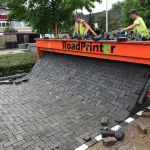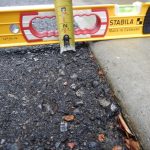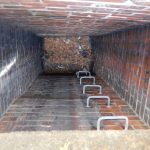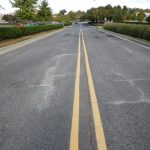We have mentioned in earlier posts that placing an interlocking or paver pavement is labor intensive. The preparation is similar to placing a flexible pavement. The subgrade has to be graded and compacted. An aggregate layer placed and compacted. The difference is an added 1-inch sand layer. Typically, pavers are hand-placed. There are two […]
We Keep Putting Stuff in Asphalt Concrete
There are two parts to the “holy grail” of asphalt concrete pavement performance: slow pavement cracking and reduce rutting caused by high truck traffic volumes. To this end, after modifying the aggregate blend, state highway departments and research universities seek additives to the simple mixtures of asphalt cement and well-graded […]
Accessibility: Curb Ramps
A national retailer has a distinctive entranceway with three large planters. Curb ramps are constructed between the planters and tiles pave the plaza area to the doors. It is a nice, secure design which eliminates the need for bollards. The problem we find is the curb ramps typically have running […]
Miscellaneous
Here is an unusual cart corral using concrete curbs to hold the carts in place. Note the small wheel stops to prevent carts from rolling away. This design would be a problem in the snow belt where plows would rip it out. It may also be a tripping hazard for […]
Accessibility: Curb Ramp Joint with the Pavement
Too large a troweled edge on a curb ramp can result in a noncompliant ramp. Illustrated in the photograph there is a 3/4-inch radius and a just about a one-inch differential elevation. The United State Access Board “Guide to the ADA Standards” expands on the issue of edges on accessible […]
Accessible Curb Ramp
This is a picture of an ADDAG compliant curb ramp. Depending on the jurisdiction and/or plaintiff’s expert, it could be identified as noncompliant because the curb ramp width does not match the crosswalk width. The reasoning is the accessible path is the crosswalk width. The ramp sides, or flares, are […]
I look into your storm sewers and you should too
What am I looking for? First, I look at the construction. The common in-pavement structures are sanitary sewer manholes, stormwater inlets and catch basins, and utility vaults such as electric and telephone/fiber optic. Concrete pipe is common construction. Older manholes can be constructed of brick and mortar. At the top of the structure can […]
Pavement Preservation: Timing of a Seal Coat
We are often asked, “When is the best time to seal coat a new asphalt concrete pavement?” Our thinking has evolved from four to five years to one or two years after paving. The reasoning is the early seal coat application seals the surface porosity before too much oxidation has […]
Pavement Performance: What is Going on Here?
From a cursory glance of the photograph, you could think mud had dropped from a pickup truck. An experienced engineer see that the light-colored markings are mineral fines (the powdery portion of crushed rock) being leeched out of the pavement structure by subsurface water pressure. The source could be, excess […]
Accessible Curb Ramp: Noncompliance
The above photograph is of a non-compliant curb ramp where the side slopes are too steep and there is not a flat landing area. When looking at it more closely we determined a standard perpendicular ramp wouldn’t fit. The sidewalk is 8 feet wide and installing a typical curb ramp […]









